
ICASSP is the world’s largest and most comprehensive technical conference focused on signal processing and its applications. The 2019 conference will feature world-class presentations by internationally renowned speakers, cutting-edge session topics and provide a fantastic opportunity to network with like-minded professionals from around the world. Visit website.

- Read more about Fast Edge Preserving 2D Smoothing Filter using Indicator Function
- Log in to post comments
Edge-preserving smoothing filter smoothes the textures while it preserves the information of sharp edges. In image processing, this filter is used as a fundamental process of many applications. In this paper, we propose a new approach for edge-preserving smoothing filter. Our method uses 2D filter to smooth images and we apply indicator function to restrict the range of filtered pixels for edge-preserving. To define the indicator function, we recalculate the distance between each pixel by using edge information. The nearby pixels in the new domain are used for smoothing.
- Categories:
 69 Views
69 Views
- Categories:
 16 Views
16 Views
Training deep neural networks is a computationally expensive task. Furthermore, models are often derived from proprietary datasets that have been carefully prepared and labelled. Hence, creators of deep learning models want to protect their models against intellectual property theft. However, this is not always possible, since the model may, e.g., be embedded in a mobile app for fast response times. As a countermeasure watermarks for deep neural networks have been developed that embed secret information into the model.
- Categories:
 25 Views
25 Views
- Read more about Exact Recovery by Semidefinite Programming in the Binary Stochastic Block Model with Partially Revealed Side Information
- Log in to post comments
Semidefinite programming has been shown to be both efficient and asymptotically optimal in solving community detection problems, as long as observations are purely graphical in nature. In this paper, we extend this result to observations that have both a graphical and a non-graphical component. We consider the binary censored block model with $n$ nodes and study the effect of partially revealed labels on the performance of semidefinite programming.
- Categories:
 54 Views
54 Views
- Categories:
 38 Views
38 Views
The performance of automatic speech recognition systems(ASR) degrades in the presence of noisy speech. This paper demonstrates that using electroencephalography (EEG) can help automatic speech recognition systems overcome performance loss in the presence of noise. The paper also shows that distillation training of automatic speech recognition systems using EEG features will increase their performance. Finally, we demonstrate the ability to recognize words from EEG with no speech signal on a limited English vocabulary with high accuracy.
- Categories:
 42 Views
42 Views
- Read more about BASELINE WANDER REMOVAL AND ISOELECTRIC CORRECTION IN ELECTROCARDIOGRAMS USING CLUSTERING
- Log in to post comments
- Categories:
 5 Views
5 Views
- Read more about QUESTION ANSWERING FOR SPOKEN LECTURE PROCESSING
- Log in to post comments
This paper presents a question answering (QA) system developed for spoken lecture processing. The questions are presented to the system in written form and the answers are returned from lecture videos. In contrast to the widely studied reading comprehension style QA – the machine understands a passage of text and answers the questions related to that passage – our task introduces the challenge of searching the answers on longer text where the text corresponds to the erroneous transcripts of the lecture videos.
- Categories:
 88 Views
88 Views
- Read more about QUESTION ANSWERING FOR SPOKEN LECTURE PROCESSING
- Log in to post comments
This paper presents a question answering (QA) system developed for spoken lecture processing. The questions are presented to the system in written form and the answers are returned from lecture videos. In contrast to the widely studied reading comprehension style QA – the machine understands a passage of text and answers the questions related to that passage – our task introduces the challenge of searching the answers on longer text where the text corresponds to the erroneous transcripts of the lecture videos.
- Categories:
 12 Views
12 Views
- Read more about A FULLY CONVOLUTIONAL NEURAL NETWORK FOR COMPLEX SPECTROGRAM PROCESSING IN SPEECH ENHANCEMENT
- Log in to post comments
In this paper we propose a fully convolutional neural network (CNN) for complex spectrogram processing in speech enhancement.
- Categories:
 152 Views
152 Views